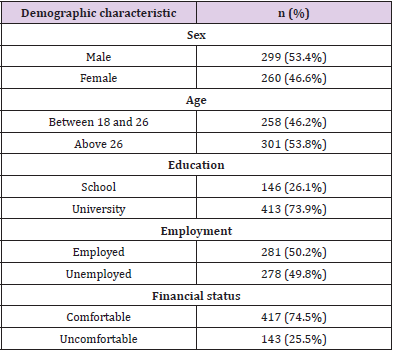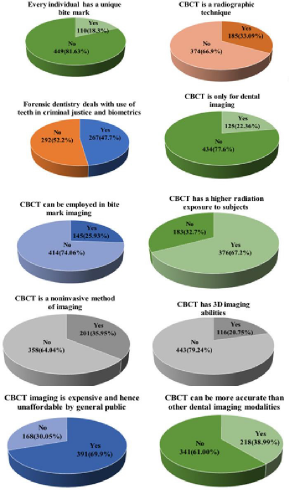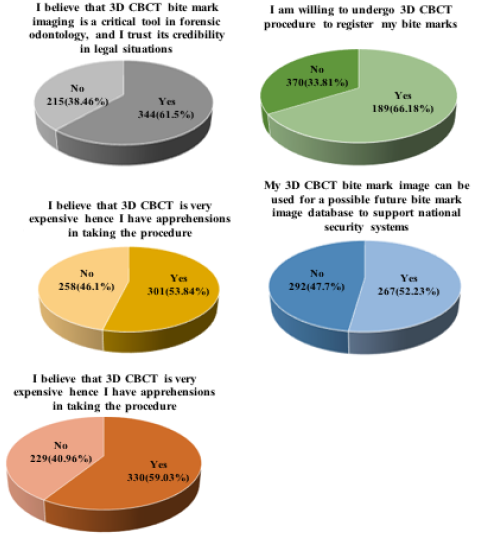Abstract
Objective: The aim of this study was the societal evaluation of the knowledge and acceptance for 3 dimensional Cone Beam Computed Tomography (3D CBCT) being used as a mode of imaging for human bite mark image acquisition and a future biometric repository of bite mark images among general public of Riyadh, Saudi Arabia.
Methods: A cross-sectional study based on a self-administered survey questionnaire was conducted comprising 15 multiple choice questions. The knowledge and acceptance related to the usage of 3D CBCT in human bite mark imaging were assessed with 10 questions which were oriented on knowledge of 3D CBCT and 5 questions on the acceptance of 3D CBCT imaging procedures from the bite mark imaging point of view. The responses were assessed based on demographic factors and the relationship between knowledge and acceptance are statistically defined.
Results: A total of 743 surveys were initially collected, but after the exclusion of those with >20% missing responses to statements, 559 (75.23%) were analyzed. More than half of the study participants (61.5%) agreed that 3D CBCT imaging can be an accurate and a sensitive means of obtaining human bite marks. In addition, 52.23% of study participants believed that a national level 3D CBCT based bite mark registry could assist with law enforcement. The mean positive response rate regarding the participants’ acceptance of a 3D CBCT bite mark imaging was 64.7 ± 25.5%.
Conclusion: This research suggests that although 3D CBCT is a promising imaging modality for bite mark imaging in forensic odontology a gap in knowledge and awareness was found among general public. So, efforts should be made to increase the awareness and knowledge regarding 3D CBCT and its imaging benefits outside the typical clinical uses. The knowledge, awareness and benefits of three dimensional CBCT based bitemark images can be imparted in general public through printed, film and social media, and dental care facilities.
Keywords: Three-dimensional CBCT; Awareness; Societal evaluation; Bite mark imaging; Forensic Odontology
Introduction
Cone Beam computed Tomography (CBCT) is currently being universally utilized for various dental applications and research projects. However, there have been varied opinions regarding the appropriate use of 3D CBCT in the field of forensic odontology. A huge majority of the scientific community continues to describe and quantify the three-dimensional bite patterns in two dimensions which implies distortion and loss of information [1]. The recent development of three-dimensional methods for bite mark analysis has become a highlighted procedure when compared to the traditional methods [2,3]. The knowledge in using CBCT in bite mark analysis is not widely exploited and hence its social outcome is debatable, which is why this study is crucial in evaluating the social and economic impact of bite mark analysis outcome using 3D of CBCT. In this study the target respondents are the adult public of Riyadh, Saudi Arabia to assess their knowledge and hence their awareness towards human bite mark image using 3D CBCT and a possible bite mark registry for a future biometric purpose.
Material and Methods
A cross-sectional study based on a self-administered survey questionnaire was conducted in this study. The questionnaire was prepared comprising of 15 multiple choice questions, to assess the knowledge and acceptance related to the usage of 3D CBCT in human bite mark analysis. 10 questions framed were oriented from 3D CBCT technical knowledge and 5 questions on the acceptance of 3D CBCT procedures from the bite mark imaging point of view. The participants were questioned about their demographic data and responded to statements using the alternatives ‘‘Yes”, ‘‘No”, or ‘‘Don’t know”. Their perception towards 3D CBCT based bite mark analysis was assessed using the 15 statements and a 5-point Likert scale. The Percentage Mean Score (PMS) of knowledge, the Mean Positive Response Rate (MPRR) of participant perception, and their acceptance to undertake 3D CBCT imaging to be involve in a prospective dental bite mark image registry were assessed with respect to their demographic characteristics. The survey was distributed through online methods that included the use of an online platform (Survey monkey) as well as distribution of the softcopy of the questionnaire through WhatsApp groups and personal E‑mails, whilst the manual questionnaire was distributed to patients and bystanders of the REU dental hospital. Eligible Arabian nationals and non-nationals, who were willing and capable of responding to the survey statements.
The survey was self-administered and conducted both in English and Arabic to ensure that there was no language barrier to comprehension. It was composed of an introductory letter explaining the study objectives, an informed consent page, and the data collection tool. The introductory letter explained the purpose of the study and invited the participants to contribute voluntarily at their own leisure. Written informed consent was provided by participants signing an ‘‘Agreement to Participate” statement. The contact information of the principal investigator was stated as a reference, in case any further clarification was needed by the participant. The 15 statements of the questionnaire were scored as one if the participants responded ‘‘yes” and zero if the participants responded ‘‘no” or ‘‘don’t know”. The statements covered various aspects of bite marks in forensic odontology, the knowledge of 3D CBCT technology and the perception of privacy about bite mark image profiles stored. SPSS version 21.0 was used for data entry and analyses. Descriptive statistics, such as the means and standard deviations of the scores, and the frequencies and percentages of all the independent variables are analyzed. Responses in the knowledge and acceptance domains were presented as frequencies and percentages, and then converted to percentage mean ± standard deviation scores and MPRR. Analytic statistics were applied to test the associations between knowledge or perception and participant characteristics. The t-test was used for normally distributed data and the Mann Whitney test used for non-normally distributed data. To predict the significant factors associated with acceptance of 3D CBCT in bite mark analysis, binary logistic regression analysis was performed. The statistical significance level for this level was set at p< 0.053.
Results
A total of 743 surveys were initially collected, but after the exclusion of those with >20% missing responses to statements, 559 (75.23%) were analyzed. Most of the study participants were from Riyadh (71.5%). An approximately equal sex distribution was obtained, with men comprising 53.4% of the sample. Participants of <26 years of age constituted 46.2% of the sample, which had a mean ± standard deviation age of 28.4 ± 9.0 years. Almost 78% of the participants had obtained a university education. Half of the participants were employed (50.2%) and 74% were comfortable in their financial status (which can influence willingness to undertake dental procedures). The participants’ demographic characteristics are given in Table 1. The responses to individual knowledge statements of 3D CBCT bite mark imaging and bite mark analysis are given in Figure 1, with the responses to individual acceptance statements to bite mark analysis using 3D CBCT given in Figure 2. Most participants answered incorrectly when they were asked if everyone has a unique bite mark (81.63%). When asked if 3D CBCT does expose one to higher radiation than usual radiography, 67.2% of participants responded correctly. The overall percentage mean ± standard deviation of the knowledge scores was 39.8 ± 22.5%. Most of the participants (53.84%) said that they think it is expensive to undergo 3D bite mark registration using CBCT, and 61.5% said that they have high acceptance of the bite mark images obtained through 3D CBCT procedure.
More than half of the study participants (61.5%) agreed that 3D CBCT imaging can be an accurate and a sensitive means of obtaining human bite marks. In addition, 52.23% of study participants believed that a national level 3D CBCT based bite mark registry could assist with law enforcement. When asked about the accuracy and sensitivity of 3D CBCT applications to other dental specialties, 61.6% of participants responded positively. The mean positive response rate regarding the participants’ acceptance of a 3D CBCT bite mark imaging was 64.7 ± 25.5%. In relation to their knowledge regarding bite marks and 3D CBCT, the female study participants (PMS ± SD = 45.3 ± 20.2) and participants with higher level of formal education (PMS± SD = 40.8 ± 22.5) had better knowledge than male or less well-educated participants (p < 0.001 and p = 0.014, respectively). Table 2 shows the relationships between level of knowledge and acceptance of 3D CBCT in bite mark image registration and the participants’ demographic characteristics.
This study evaluated the societal which is the socio-economic impact and hence the user outcome of 3D CBCT in bite mark imaging. The performance of any dental procedure, such as the collection of a bite mark image, requires the informed consent of the participants, involving the clear statement of the participants’ rights and obligations [4]. This study shows that there is a major influence of socio-economic status influence on the acceptance of 3D CBCT imaging in bite mark registration. This study has sought to identify the perspective of the public regarding 3D CBCT procedures, to identify any frequent gaps in personal knowledge and to help resolve any misperceptions. Thus, this study presents a preliminary feasibility assessment, with respect to public attitudes, on accepting 3D CBCT as a general mode of bite mark registration. In this study, the leading misconception identified was regarding the radiation exposure concerns involved in 3D CBCT imaging. It is seen that the public is not very aware of newer dental imaging technologies like CBCT. Bite mark analysis is not fully understood by the general public. A vital component in increasing the public’s acceptance to 3D CBCT bite mark imaging can be done through social media, television, and healthcare facilities. The perception of acceptance by the public to 3D CBCT reflects how they feel and what they fear and/or prefer. Increasing the knowledge of potential participants is one important way that any misconceptions can be corrected, and expectations set appropriately [5]. This study highlights that each perception statement used in the present survey represents an opportunity to improve knowledge. For instance, the largest negative response rate among the participants was regarding their feeling that the retention of their 3D CBCT bite mark image records represent an invasion of their privacy. This study has evaluated the societal impact and outcome of 3D CBCT bite mark imaging of the public and it gives a positive response in general.
Summary
This study is a pioneer in reporting the societal evaluation the CBCT imaging system for the benefit of bite mark imaging in forensic odontology. The higher efficacy of CBCT in forensic odontology is the theme seen as a result of the evaluation. The 3D imaging facility of CBCT is a potential tool in forensic applications and more evaluation studies should be initiated in this field.
References
- Giri S, Tripathi A, Patil R, Khanna V, Singh V (2019) Analysis of bite marks in food stuffs by CBCT 3D-reconstruction. Journal of oral biology and craniofacial research 9(1): 24.
- Janardanan RP, Logeswaran R (2020) Evaluating Current Dental Imaging Modalities for Human Bite Mark. Int J Cur Res Rev 12(21): 163.
- Dalessandri D, Tonni I, Laffranchi L, Migliorati M, Isola G, et al. (2020) 2D vs. 3D Radiological Methods for Dental Age Determination around 18 Years: A Systematic Review. Applied Sciences 10(9): 3094.
- Bonamici J (2020) Reproducibility of Dental Bite Registrations Using a Direct Intraoral Scanner.
- Chen L, Baird A, Straub D (2019) Why do participants continue to contribute? Evaluation of usefulness voting and commenting motivational affordances within an online knowledge community. Decision Support Systems 118: 21-32.

 Research Article
Research Article



